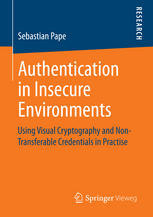

Most ebook files are in PDF format, so you can easily read them using various software such as Foxit Reader or directly on the Google Chrome browser.
Some ebook files are released by publishers in other formats such as .awz, .mobi, .epub, .fb2, etc. You may need to install specific software to read these formats on mobile/PC, such as Calibre.
Please read the tutorial at this link: https://ebookbell.com/faq
We offer FREE conversion to the popular formats you request; however, this may take some time. Therefore, right after payment, please email us, and we will try to provide the service as quickly as possible.
For some exceptional file formats or broken links (if any), please refrain from opening any disputes. Instead, email us first, and we will try to assist within a maximum of 6 hours.
EbookBell Team

4.4
22 reviewsSebastian Pape discusses two different scenarios for authentication. On the one hand, users cannot trust their devices and nevertheless want to be able to do secure authentication. On the other hand, users may not want to be tracked while their service provider does not want them to share their credentials. Many users may not be able to determine whether their device is trustworthy, i.e. it might contain malware. One solution is to use visual cryptography for authentication. The author generalizes this concept to human decipherable encryption schemes and establishes a relationship to CAPTCHAS. He proposes a new security model and presents the first visual encryption scheme which makes use of noise to complicate the adversary's task. To prevent service providers from keeping their users under surveillance, anonymous credentials may be used. However, sometimes it is desirable to prevent the users from sharing their credentials. The author compares existing approaches based on non-transferable anonymous credentials and proposes an approach which combines biometrics and smartcards.